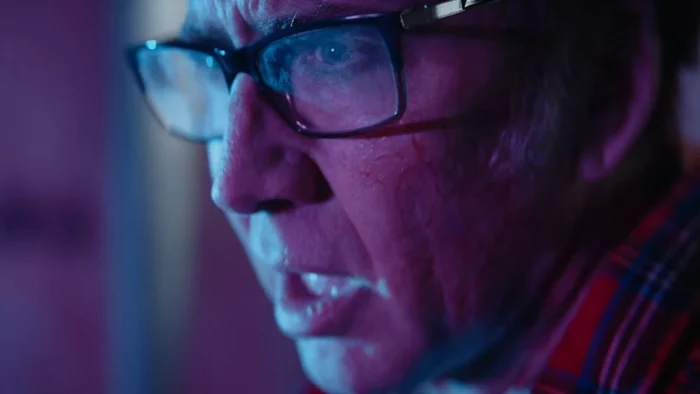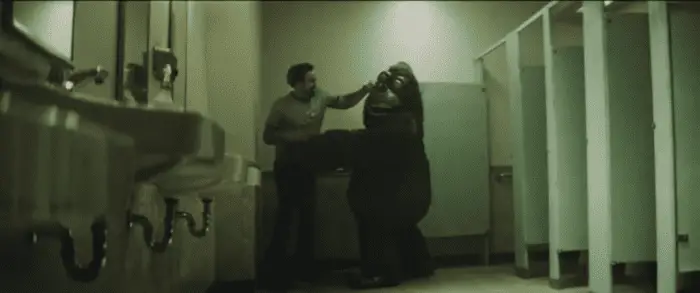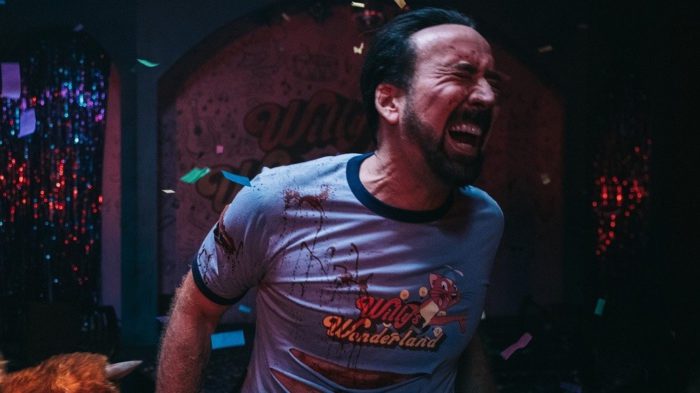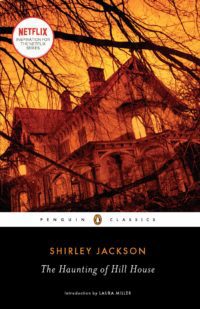I think It’s safe to say we’ve never seen anything quite like the life and career of Nicolas Cage.
For starters, he wasn’t born Nicolas Cage, he was born Nicolas Kim Coppola—yes, that Coppola. His cousins are Roman and Sofia Coppola and his uncle is Francis Ford Coppola, who you might know for directing a little film called The Godfather. Early on in his career, he changed his name to Nicolas Cage to avoid any appearance of nepotism, inspired by Marvel Comics character Luke Cage.
Next, while most actors tend to veer towards a particular genre, niche, or type of character, only venturing outside that niche to poke fun at themselves once their career has been established, Cage on the other hand has seemingly never found a genre or type of role he wouldn’t take on wholeheartedly. His first role was a small part in Fast Times at Ridgemont High. He won an Academy Award for Leaving Las Vegas. In between, he starred in the Coen Brothers’ Raising Arizona and David Lynch’s Wild at Heart.
After that Academy Award win, Cage entered into the most mainstream, most profitable period of his career, starring in films like The Rock, Con Air, and Face/Off, eventually leading him to one of his biggest roles as the lead in Disney’s National Treasure and National Treasure: Book of Secrets.

Unfortunately, after Book of Secrets came the downtimes: in the 2010s, likely fueled by the need to pay off years of back taxes owed to the IRS, Cage made an astonishing twenty-nine direct-to-video movies, most of them being the sort of forgettable stuff you might find in the $5 bin at Walmart.
Then, in 2018, came Mandy, a film virtually unlike anything we’d ever seen before, taking advantage of what was one of Cage’s best performances in years, balancing over-the-top rage with subtle humor and genuine emotion—and suddenly people started remembering what a singularly talented actor Cage was.
This brings us to today, where, at the age of 57, his career has taken yet another improbable turn: over the last few years, Cage has started making some of the best movies of his career—and, all the better for people like us, this comeback has been spearheaded by a trio of excellent horror/horror blend films: the previously mentioned Mandy, Color Out of Space, and Willy’s Wonderland.
Mandy
Mandy is a film that has to be seen to be believed. I know the phrase “fever dream” is one that is overused, but Mandy is a film that truly fits that level; it opens with the music of King Crimson accompanying the last words of death row inmate Douglas Robots and ends on Cage’s character soaked in blood and dirt while driving off into the sunrise of an otherworldly landscape.
Fortunately, I don’t have to try and explain Mandy myself, as a near-perfect description of the film already exists, courtesy of Mr. Joe Bob Briggs—someone else we happen to greatly appreciate here on Horror Obsessive. In The Last Drive-In’s episode showcasing the film, Joe Bob describes it as such: “It’s one of those horror revenge rock-opera, acid-infused love-story metalhead cenobite, biker-gang action flicks with Cheddar Goblin comic relief that goes deep into the psyche of a failed cult leader fried by LSD while going even deeper into the psychology of what happens when you burn a lumberjack’s girlfriend alive while forcing him to watch.”
While director Panos Cosmatos originally wanted Cage for the role of the villain, here he takes on the role of Red, who works as a lumberjack while living in relative isolation with his girlfriend, Mandy. When Mandy happens to be spotted by Jeremiah Sand, a Charles Manson-meets-Jim Jones type failed musician turned cult leader, he becomes obsessed with her, leading to her kidnapping and murder, and sending Red on a blood-soaked odyssey for revenge. 
Cage’s performance here is—in a word—operatic, as Red transforms from a quiet, peaceful man who works as a lumberjack and enjoys watching old movies with his girlfriend into a larger-than-life, angel of death complete with crossbow and battleaxe. The highlight of this performance comes in Mandy’s most iconic scene, coming in at just over the halfway point of the film. Red has just arrived home, after witnessing Mandy being burned to death before his subsequent escape from the cult. After a brief nightmare about Mandy, he goes to the bathroom to find a bottle of vodka he’d previously hidden there, before having a complete breakdown under the weight.
Cage is mesmerizing to watch here; without saying a word, he takes us on a complete journey through Red’s inner turmoil. He shakes with pain and exhaustion, he shrieks and howls like a wounded animal, vodka is alternately drunk and applied to open wounds before it finally ends with him breaking down into raw, strangled sobbing.
But, where at first glance one might consider this to be just another moment of the now-infamous “Cage Rage”—as internet memers have taken to referring to Cage’s more over-the-top moments and performances—here, Cage gives us a rich and layered performance. There’s a hollow, almost performative element to Red’s supposed ‘rage’—and it doesn’t last for more than a minute before the rage is nothing more than an attempt to act strong and cover up the anguish he feels over losing Mandy, before wordlessly resolving to hunt down and take revenge on the cult and setting him down the path of vengeance.
Mandy has received both a strong critical reaction and a fairly dedicated cult following, with plenty of acclaim directed towards Cage’s performance, and Cosmatos for “…[taking] full advantage of Cage’s greatness, and then some.”
Color Out of Space
Color Out of Space, adapted from H.P. Lovecraft’s short story of the same name, finds Cage starring as Nathan Gardner, who has recently moved his family to his father’s old farm after his wife’s surgery. When a meteorite lands in their front yard, the Gardners find themselves under assault by an otherworldly force that warps their minds, bodies, and even time as it seeks to remake the world into “something it knows”.
Color Out of Space nails the feel of Lovecraft, in both the visceral, physical terror of the Color warping bodies into horrifying abominations and in the existential dread that comes with the Color’s completely alien nature and motivations. The film is an unapologetically slow burn, anchored by Cage’s performance as Gardner slowly loses his sanity under the influence of the alien force that crashes into his front yard before contorting the minds and bodies of the family living there.
About halfway through the film, Gardner accidentally ingests the water that has been infected by the Color; following this, he begins to slide in and out of a sort of fugue state, with Cage adopting a distinctly different attitude, physicality, and manner of speech from normal as his mind becomes slowly lost to the Color. It’s a frightening sight to see, with Cage’s performance bringing to mind the ugly mood swings of a violent alcoholic as Gardner goes from angry and foul-mouthed one minute to apologetic and frightened in the next, seemingly without any control over himself.
Cage’s weird, distinct method of delivering dialogue really shines in this performance, highlighting the difference between Gardner’s typical personality and the more aggressive one that comes out as a result of the Color—a turn that’s just as frightening as any of the more visceral, gory results of the Color’s influence on the farm.
Cage received plenty of acclaim for his performance here, with NME going so far as to call it “…perhaps his most nuanced turn in the last decade.”
Willy’s Wonderland
Finally, we have Willy’s Wonderland. It’s a personal favorite of mine and the film that led me down the rabbit hole of Cage’s recent work—and it’s probably the weakest film out of the three. Weird how that works out.
The problem with Willy’s Wonderland is, well, not enough Cage. The film spends a lot of time with a cast of expendable teenagers as well as the town Sheriff who’s clearly letting on more than she knows. The only thing beyond Cage and his fight against the evil animatronic characters that inhabit Willy’s Wonderland that’s even remotely interesting is the insane backstory behind the residents of Willy’s—the restaurant was run by what was functionally a cult of child murderers, and when they were about to get arrested by local law enforcement they instead chose to perform a Satanic ritual/mass suicide that led to their souls winding up inhabiting the animatronics.
But Cage? Cage is something else entirely. Here he plays a cowboy-like individual identified only as “The Janitor”: a silent, mysterious stranger who rolls into town, gets trapped there, kicks ass, and drives off into the sunset—well, sunrise—seemingly undeterred by anything that gets thrown his way—even a gang of murderous, animatronic animals.

Cage’s character doesn’t say a single word throughout the film, yet every moment he’s on-screen is fascinating to watch, whether it’s the pinball runs fueled by knockoff energy drinks or the multiple montages of Cage cleaning up the various areas of Willy’s Wonderland. He even gets some of the best jokes in the movie—taking the owner’s advice to heart, The Janitor makes sure to take a break whenever the timer set on his watch goes off, even when he’s face to face with Willy himself, or in the middle of a fight between him and non-expendable teen Liv against a particularly vicious chameleon. Say what you will, but Nicolas Cage fighting an animatronic gorilla in a bathroom before finishing it off with a particularly vicious swirly is peak cinema.
Cage’s role here isn’t one of the over-the-top performances that he’s become notorious for; instead, The Janitor maintains his sense of hardened stoicism throughout the movie. Nothing seems to surprise him, impress him, or in any way distract him from his job of cleaning up Willy’s Wonderland so that he can get his car fixed and get out of town.
If I had to pick one moment from Willy’s Wonderland that sums up everything Cage’s performance goes for, it would have to be the very first encounter he has with one of the animatronics. It’s a typical jump-scare setup, with The Janitor cleaning up the main floor while the Ostrich sneakily moves behind him. When The Janitor notices something is amiss, he pokes at the Ostrich a couple of times with his mop, eventually aggravating it to the point of attack, at which point he snaps the mop in half before savagely beating down the Ostrich and ripping its mechanical spine out. It’s visceral, quick, and honestly a little ridiculous, yet The Janitor doesn’t miss a beat before doing what he needs to do to survive—and then going right back to his cleaning.
While reviews of Willy’s Wonderland itself were mixed, most critics agreed that Cage’s performance was the highlight of the film; as Empire said in their review: “Chugging endless cans of fictional soft drink Punch (“A fistful of caffeine to your kisser”) and playing pinball between kills, [The Janitor is] a super-stylized, unpindownable hoot, even stranger than the gonzo creations he’s facing.”
Final Thoughts
While his return to lower-budget, more independent fare might have started out of necessity, Cage seems to have settled in fairly well to this new phase in his career—and if you ask him, it doesn’t seem likely that he’s going back to Hollywood anytime soon.
In an interview Cage held with Variety back in July, he shares that “When I was making Jerry Bruckheimer movies back-to-back, that was just a high-pressure game. There were a lot of fun moments, but at the same time, there was also ‘We wrote this line. It has to be said this way,’…On independent movies, you have more freedom to experiment and be fluid. There’s less pressure and there’s more oxygen in the room.” Cage has clearly thrived and feels more comfortable in the environment of more independent productions, and the freedom he has in those types of shoots to experiment and truly make a role his own have yielded incredible results, and in a less pressure-filled environment, Cage can do what he does best: take a role to places that other actors can’t—or won’t.

But out of all the films he’s done recently, it’s been the horror movies that have really knocked it out of the park. Horror is a genre that particularly thrives when creating a sense of heightened, almost super-reality; a state where the world of the film is one that we can clearly recognize and relate to while having a couple of crucial elements of the unreal and over-the-top—which just so happens to be the sort of environment that synergizes perfectly with Cage’s acting style, a mixture of off-beat vocalizations, German expressionism, and unbridled intensity he refers to as “Western Kabuki theatre”. Whether he’s matching the intensity of a film like Mandy, slowly burning away at his character’s sanity in Color Out of Space, or providing a more grounded but no less intense counterpoint to the over-the-top absurdity of Willy’s Wonderland, Cage and horror films have proven to be a match made in heaven.
Finally, this late-career turn carries a very real sense of coming full circle. Independent films were where Cage made a name for himself in the industry, so while the actor may say that he’s gone off into his own wilderness, to his fans it feels very much like a long-awaited homecoming.
At this point in his career, not only does Cage show no signs of slowing down, it’s safe to say that nobody knows what he is going to do next—his latest film, Pig, was assumed by many to be another horror film but turned out to be a nuanced character study about loneliness and finding peace away from fame, something that Cage, in particular, can relate to. But it’s the horror films that have given Cage a special place in our hearts—and leave us eagerly awaiting the next time he decides to take on the genre as nobody else does.



